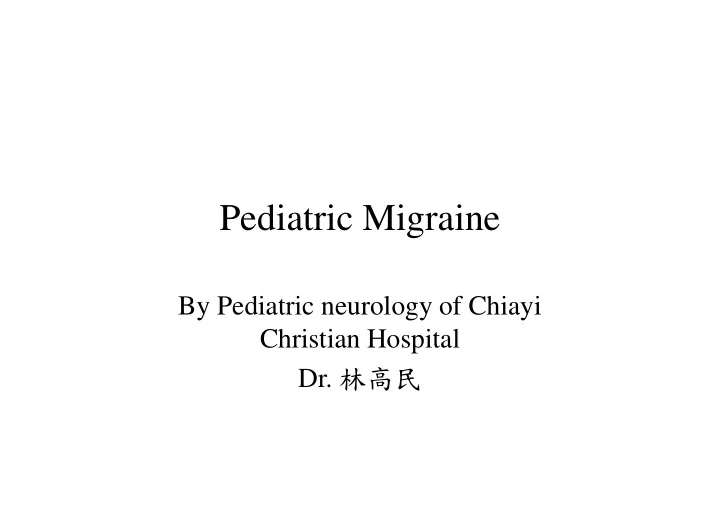

Pediatric Migraine By Pediatric neurology of Chiayi Christian Hospital Dr. 林高民
Case presentation lasting age (years) sex time (years) frequentcy location duration case 1 12 femlae 5-6 3-6/week 1/2-2 days bitemporal case 2 14 femlae 2 daily recently 1/2-1 days bitemporal avoid routine characteristics severity nausea/vomiting photophobia/ activity (self score) phonophobia 不想動 不想動 不想動 不想動 case 1 throbbing 7-8 vomiting phonophobia tightness or 躺床上 躺床上 躺床上 躺床上 case 2 8-9 vomiting phonophobia throbbing
NE optic disc blood pressure Neuroimage acute infusion sleep partially (mmHg) resolved case 1 unremarkable normal 109/66 N N Y case 2 unremarkable Normal 119/79 N Mannitol Y prophylactic oral outcome outcome predisposed medications severity frequency factor case 1 inderal(40) 1/2# bid 4-5 3/month N 基測 基測 基測 基測 case 2 tryptanol 1# qn 3 4-5/moth
Epidemiology • First report: Bille in 1962 • 75% children have a notable headache by 15 y/o • Migraine: 3.9% of 7-15 y/o Migraine: 3.9% of 7-15 y/o 1.7% in 7 y/o to 5.3% in 15 y/o Acta Paediatrica Suppl 1962; 136: 16-151
Headache 2009; 49: 697-703
23.4% Headache 2010 Feb;50(2):210-8
Pathophysiology- Genetics • CACNA1A (Ca channel) • ATP1A2 (Na/K pump) • SCN1A (Na channel): familiar hemiplegic migraine • Chromosome 14q32 Chromosome 14q32 • Serotonin transporters gene • KCNN3 (K channel) • 5,10-methylenetetrahydrofolate (MTHFR) • Angiotension-converting enzyme • Matrix metalloproteinase 3 Lancet Neurology 2010; 9: 190-204
Pathophysiology- Biological changes • No biological markers • increase: Interleukin-1 � sTNF receptor 1 TNF calcitonin gene-related peptide • Decreased: coenzyme Q10 Lancet Neurology 2010; 9: 190-204
Pediatrics international 2008; 50, 620-623
Pediatrics international 2008; 50, 620-623
Indian journal of pediatrics 2008; (75), 1139-1148
Diagnostic criteria- Migraine without aura
Pediatric migraine Indian journal of pediatrics 2008; (75), 1139-1148
Characteristics of pediatric migraine • Short duration • Sleep should be included as part of duration • More likely to be bilateral (frontal-temporal) • Photophobia and phonophobia by child’s action Photophobia and phonophobia by child’s action • Occipital location should be further assessment Lancet Neurology 2010; 9: 190-204 Curr Opin Neurol 2010 Jun;23(3):249-53 • More description of tightness pain
Difficulties in young children • Poor detail descriptions • Anxiety of parents • Brain tumor, esp. posterior fossa • Frequent head hitting • Uncooperative to PE and NE • Lost follow-up • Psychological interference
PedMIDAS: migraine migraine disability assessment
Associated symptoms • Osomophobia: sensitive and specific from TTH • Cutaneous allodynia Lancet Neurology 2010; 9: 190-204 Curr Opin Neurol 2010 Jun;23(3):249-53
Further Assessment • Children difficult to obtain accurate responses • Parental reponses by their own experiences • Children’s drawings Lancet Neurology 2010; 9: 190-204 Curr Opin Neurol 2010 Jun;23(3):249-53
Examination • Complete history • General examination • Neurological examination • Neck tenderness and stability • Neck tenderness and stability • Stability of temporomandibular joint • Sinus and facial tenderness • General cranial palpation • Muller’s sign Lancet Neurology 2010; 9: 190-204
Differential Diagnosis • Sinus headache: Muller’s sign • Moyamoya disease • Psychological problems: school phobia and anxiety anxiety
Neuroimaging • Neurological examination is the most sensitive test to identify the need for neuroimaging. • Need: occipital location (posterior fossa tumor) • No need: long standing No need: long standing recurrent do not change with a normal NE Lancet Neurology 2010; 9: 190-204
Lancet Neurology 2010; 9: 190-204
Acute treatment • NSAID (Ibuprofen): 7.5-10mg/kg/dose • Triptans: more severe Almotriptan by FDA nasal sumatriptan and zolmitriptan by EMEA Lancet Neurology 2010; 9: 190-204 CNS Drugs 2006; 20(10): 813-820
Prophylactic Medicatins • Antihistamine: cyproheptadine • Antidepressants: Amitriptyline, Nortriptyline, Duloxetine • � -blockers: propranolol � -blockers: propranolol • Calcium channel blockers: verapamil • Anticonvulsants: Topiramate, Valproic acid Semin Pediatr Neurol. 2010 Dec;17(4):224-9
Non-pharmacologic treatment • Nutraceuticals: coenzyme Q10, butterbur, riboflavin, magnesium • Biobehavioural therapy Lancet Neurology 2010; 9: 190-204
Thank you!
Recommend
More recommend